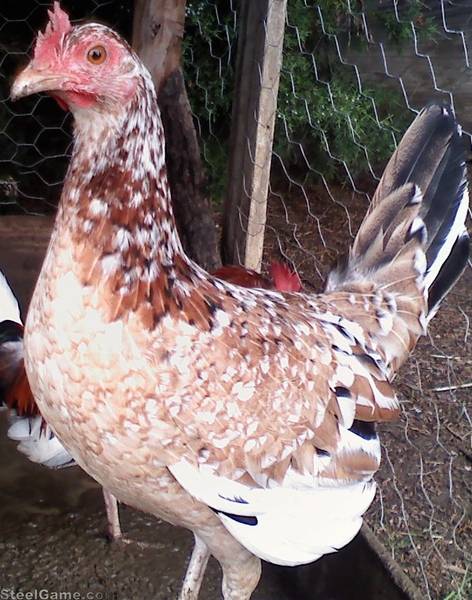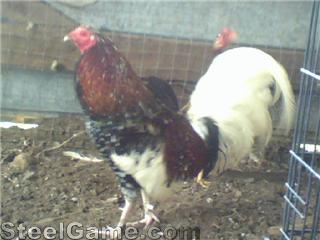
At the Shades on Ellis street this cock was pitted against a fine cock in the hands of Ike Little. He had an old brood cock called "Store Keeper" that had a habit of lounging around inside of the Irishman's store and bar and flopping his wings and crowing when the town clock pealed forth the hour. Sherron is said to have made stacks of money fighting these cocks against the rich planters around Augusta. Be this as it may, Sherron at least, believed it and certainly it is thousands of subsequent importations from Ireland have shown no such game fowl as the Stone Brown Reds. He claimed to have carried a coon and opossum over from America and that one of the wardens on this estate was so infatuated with the animals that he stole a trio of these sacred chickens and gave them in exchange for the American rodents. Stone's Irish agent told when he procured a trio of birds from a flock that had been carefully and zealously guarded for a century or over: that they were the best in Ireland and so far as known not a feather had ever gone out of the possession of the owners of this particular estate.


He claimed to have known this stock in Ireland and that they were invincible in the old country, but unobtainable from the estate on which they had been bred by a line of Irish Earls for more than a century. Sherron was an Irishman, a cocker on the sod and again in America. Later on Foster quit pitting cocks on account of his corpulency and gave every feather over to Peter Sherron, with the understanding that latter would take Foster on as partner in all battles fought with these cocks. Then Dunbar carried them out to old man Bladwin's place on Horse Creek, where they were kept and bred for Dunbar until he quit fooling with cocks and gave them all to Joh Foster. Seiley kept them one year and gave them up. The trio of "Irish Brown Reds" Dunbar sent out to Tom Seiley's place and Mr. Rhett purchased hens of Tom Wilson and bred his Stone cock over them producing the celebrated Rhett fowl of which it is said there was never a runner. Morgan got from Wilson and were afterward known as Morgans. These afterward became famous under the name of "Gailor Legs." It was of this family that Dr. The Gliders, Dunbar sent over to Tom Wilson at Beach Island to breed. Dunbar went to Marblehead and selected these trios in person. Stone and had shipped him from Marblehead a trio of each family. Burnett Rhett purchased the finest cock Stone showed in his main, a 6.00 lbs mottle breast brown red with moccasin legs, said to be a cross of Glider and Irish. Stone's coops at the pit and later received a shipment of six hens from Marblehead, three wheaton colored Gliders and three whippoorwill brown Irish hens. Bacon purchased a Glider and an Irish cock out of Mr. Stone by the Southerners and when he returned to Marblehead, shipped at least two coops of fowl back to parties in Georgia and South Carolina. These he called his "Irsih Brown Reds."Īfter the main there were several cocks purchased of Mr. All smooth heads and single, straight comb with black faces, comb black or sooty looking, eyes dark red or hazel brown (not black) and lead or dark legs. The other cocks he showed were brown and mahogany reds. These he called Gliders or Claibornes and I am informed that occasionally one showed a tassel and some few a round head with pea comb. One portion of them showing bright red plumage, black or mottled breast, orange hackle, yellow beak and moccasin legs stripped on the outside with flesh colored red.

Stone used against Bacon two styles of cocks evidently of different families and distinctive in appearance. Tom Bacon a main of cocks at Columbia, S.C. To begin, I will go back to the year 1855, when John Stone of Marblehead, Mass., came south and fought and defeated Col. Of the former there are others much better qualified to speak, nor do I pose as an authority on the Warhorse, or claim to know their history better than many, but I do know the facts regarding their name, their ancestry, and the only known true source from which the pure stock could have been obtained. Manifestly the reference is to the Whitehackles of North Briton and the Stone Irish or Warhorses of Ireland. Regular live chatters of >įashion is a eccentric in the course it takes and goes chasing through a labyrinth of paths most unheard of and ridiculous, but once steadied and on the serving back to reason ever turns first to some past object of popular and meritorious favoritism, hence it is not surprising that the fancy of game chicken men is turning just now to the two greatest families if fighting fowl ever sent of America from the British Isles.


 0 kommentar(er)
0 kommentar(er)
